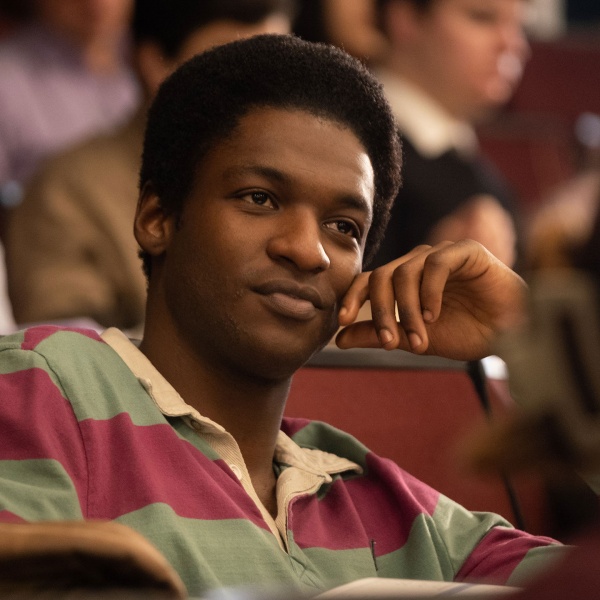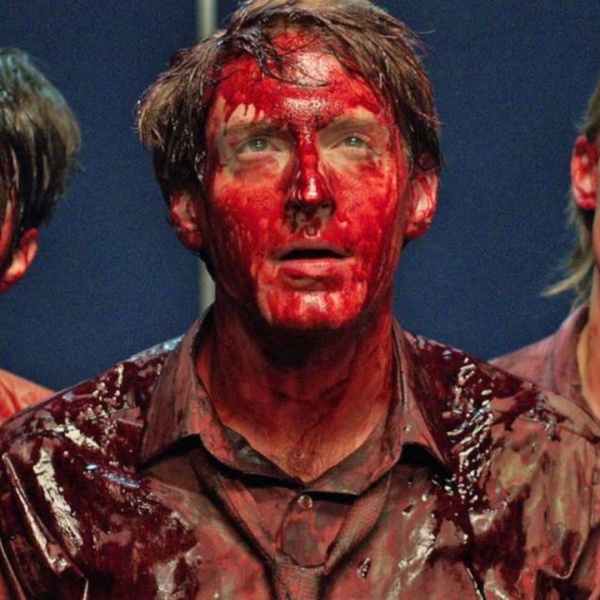
The following is a reprint of our interview with director Joe Cornish at SXSW.
By all accounts, it’s been a remarkably strong SXSW festival so far, with a number of films picking up extremely positive buzz, or adding to the buzz that was already behind them. First and foremost among them was “Attack the Block.” We’ve been looking forward to Joe Cornish‘s directorial debut ever since we read the script last year, and when the first trailer hit a few weeks back, it looked like our hopes might have been realized. And boy they were: our review from the weekend gave it a big fat A-grade, and called it “the ideal midnight movie.”
We were lucky enough to sit down with Cornish — famous in the U.K. for his partnership on TV and radio with Adam Buxton, and in the U.S. for co-writing the scripts for “The Adventures of Tintin: The Secret of the Unicorn” and “Ant-Man” with Edgar Wright — over the weekend. We managed to get all kinds of insight into the development and production of his storming debut feature, in what we’re sure will only be the first in an exciting career ahead of him. Ten highlights from our chat follow below.

The film was born from a real life incident.
“I was mugged in 2001 by a group of kids, a bit like [Jodie Whittaker‘s] character in the film, and that was the germ of the idea. Then I went to see ‘Signs‘ the following year or the year after, I’m quite a big fan of certain elements of ‘Signs.’ And that reminded me of the film, of the screenplay, ‘Night Skies‘ the [unmade] John Sayles screenplay, that then became ‘E.T.‘ and ‘Gremlins.’ I always loved the idea of an alien siege movie, and that was it. I put the two together and I thought what would happen if my mugging had been interrupted by something fantastical, would it change my relationship to those kids?”
However, the film’s influences are diverse, and not always immediately obvious.
“I looked at the world [the kids] lived in, I looked at them and they were weirdly cinematic, they were like bandits or ninjas, I looked at their vehicles; their bikes reminded me of ‘E.T.,’ their motorbikes reminded me of the speeder bikes in ‘Return of the Jedi.’ I looked at the places where they lived, housing estates they call them in the U.K., this ’50s and ’60s architecture that at the time was inspirational and futuristic but now is seen as a signifier of urban deprivation and I thought, why not? Why not make it look like ‘Logan’s Run‘ or ‘A Clockwork Orange‘ again? Even the maps the estates in the U.K. have these maps, these charts, you know? And those reminded me of the maps you get in the flyleaf of ‘The Hobbit,’ of when I would read an adventure book as a kid and you’d get a map on the inner sleeve, and you’d think ‘Wow, this terrain for adventure, what’s going to happen?’ So I was looking for places where I could find science fiction, including the language. It reminded me of a knapsack in ‘Clockwork Orange’ or books that I loved like ‘The Color Purple‘ or books that are written in Argot that you understand by osmosis.”
The Spielberg-style blend of fantasy and realism, something absent from most contemporary genre movies, was at the forefront of Cornish’s mind.
“For me one of the reasons all of these alien movies are coming out is because there’s a generation who were kids during the Lucas or Spielberg era, a phenomenal era. And they had something that contemporary movies don’t, which is a mix of reality and fantasy. Actually, ‘E.T.’ is like a Ken Loach film or a Robert Altman film, it’s an observational drama, don’t you think? It’s kind of a realist drama, the scenes with the kids are playing dungeons and dragons…the genre used to be a bit more mixed up. Contemporary movies are a bit more…they’re either totally for children, or totally for horror fans, but with those Spielberg and Lucas films of the ‘80s you wouldn’t be entirely sure what you were getting. The British cinema has a very strong realist tradition dating back to the ’60s and it has a very strong fantasy tradition that kind of, for some reason stops in the ’70s, early ’80s. To my mind no one had to go mixing the two and that’s what I wanted to do, I wanted to put, like, one droplet of fantasy into a glass of reality and mix it up.”

The photographer Charlie White (see image immediately above) was another key influence
“There’s a terrific American stills photographer called Charlie White… you’d probably recognize his photos if you saw them, he puts aliens in domestic environments. There’s one incredible photo that he did which very much inspired me of these kind of, they look like Mexican kids, and they’ve got the severed head of an alien on a chain and they’re poking it with a stick and holding it up, and I used that to develop the script, I showed that to loads of kids, that particular photo, by Charlie White.”
It was important that the creature had a tactile, physical quality.
“I was convinced I needed an actual physical thing in the room with the kid, I was asking them to do a lot to act and perform the parts, and I thought it would just be too much to have them respond to tennis balls on sticks and stuff. Plus I couldn’t afford it, you know, I couldn’t afford 3D CGI creatures and I wanted them to interact with domestic environments. I couldn’t afford to smash a CGI table, I couldn’t afford to smash a CGI window and if they smashed a window I wanted it to land on the kid, I wanted him to have something to stab and fight, I wanted it to be physical.”
Cornish is as bored of CGI monsters as the rest of us.
“I have CGI fatigue… They all look the same and it’s counterintuitive to me, if you’re creating a fantasy monster, why make it photo realistic? I miss the authorship, and the style, and the whole handcrafted feel of those ’80s movies. You know when I saw ‘The Dark Crystal‘ as a kid, I could go and do a puppet show version of it at home, and you can’t do that with Harry Potter… It’s even affected the action figures, if you look at the difference between the ’70s kind of action figures and the contemporary ‘Star Wars‘ figures, I don’t know, I just like the simplicity.”
Cornish wasn’t prepared to sacrifice the reality of the world he paints for a more teen-friendly certificate
“I haven’t really thought, were it to get released in the States, what certification it would have. I guess the language is quite strong. And that’s often a risk with films. I can think of a few great films that kind of fall between two stools, that are a bit racy for kids, and they’re a bit kiddish for adults. I didn’t really think about that hugely. All I know is it reflects, the language reflects the truth of those kids. I don’t think it’s too horrific… perhaps that’s a reflection in the U.K… the dangers that are out there for kids and the violence that does happen between gangs and to kids all over London is very real.”

It was important to use a blend of established actors and newer, rawer talent.
“It wasn’t hugely pre-meditated, that’s just kind of how I wrote it… what was important was to find out who could blend with the kids because obviously you’ve got trained actors and raw actors and, you know, Luke [Treadaway] and Jodie [Whittaker] and Nick [Frost], it’s adventurous for them to even agree to be in the film. You know first time director, all of these first time actors, so just by saying yes, one knew that they have a generosity of spirit. One of my all time favorite films is ‘Over the Edge,’ and just that film has an authenticity, and the kids have a swagger and a confidence, it’s like they’re better than the film. And they’re not beaten down by the industry or any sense of career, it’s like “you’re privileged to be pointing a camera at us,” — the swagger that Matt Dillon has — and I just wanted to keep that confidence and keep the ownership of it. I love European cinema, I like movies where you don’t recognize the protagonists and you can really believe they are who they are.”
He’s happy for the film to follow in the footsteps of “Shaun of the Dead” and become a slow-burning cult hit
“I was telling Edgar, ‘Shaun of the Dead‘ took a while to get…to gain purchase in America and my film is very different so I kind of…in no way am I expecting this to hit in the U.S. It would be fantastic if it did, and I’d love it to have the opportunity to, but I’ve got no great expectations. But at the same time I hope there’s an audience for it over here. I think you guys are probably like me, I like to discover a film that isn’t the one that’s mass marketed because I feel I own it, and I can tell my friends about it. If my film could be a film like that than that would be terrific.”
He’s in no rush to follow up “Attack the Block”
“Me and Edgar are finishing off an ‘Ant-Man’ draft for the next couple of weeks, and then I have a radio show in the U.K. that I do every Saturday so I’m going to go back to that for the summer and I’ve got a lot more ideas. I’m in no hurry, I want to get it right, whatever I do I want to try and get it right. I’m not going to hurry to do the next thing, I kind of want to take my time, but it’s the day after my first screening, so I’m just kind of enjoying that for the moment.”
“Attack The Block opens on July 29th. Interview by RP




